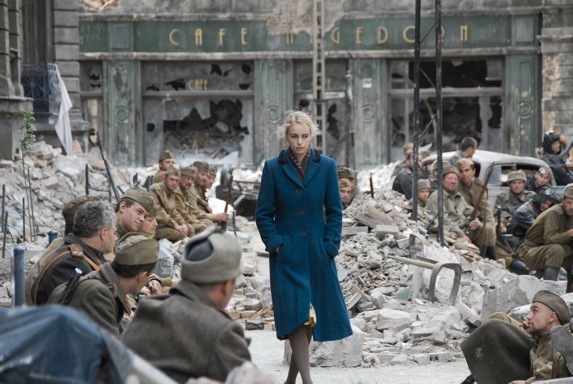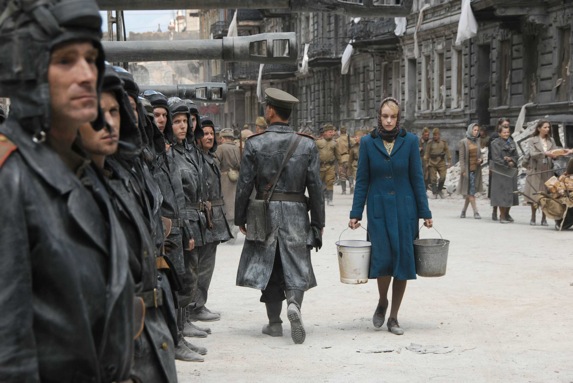Click here to print
Framing German Wartime Suffering
posted November 21, 2010
By Peter Monaghan
The more comfortable you are with the notion of retributive justice – and with its gory manifestations – the less bothered are you likely to be with what happened to German citizens in the closing phases of the Second World War.
You wouldn’t be alone in thinking little about the events that so devastated the defeated nation and put paid to the genocidal intentions and actions of so many leaders and citizens. The last phase of the war was so bloodcurdling that for most of the years from 1939 until the beginning of this millennium, Germans themselves said little about the Allied bombing campaigns that razed German cities and incinerated populations; about the mass rapes of German women by soldiers of an invading Red Army bent on avenging Russian deaths from German actions that exceeded 20 million; about the expulsion of 12 million people from previously German regions east of the “Oder-Neisse Line”–within redrawn Polish borders–in a brutal ethnic cleansing that resulted in some 2 million deaths.
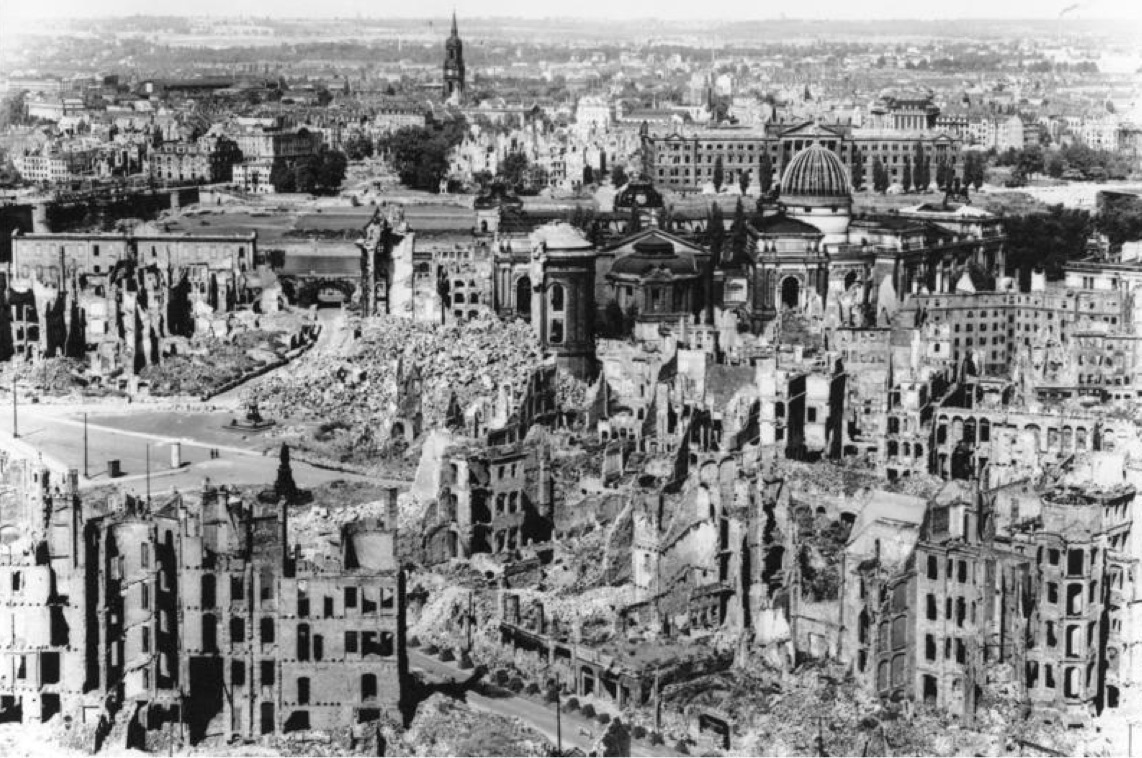
As the extent of Nazi criminality emerged and became widely known, even raising the concept of German citizens suffering came to seem an obscene intervention.
And yet, as a few considered books are now making clear, those events continued to haunt individual and collective Germans memories, and to find expression in fiction and non-fiction books and in feature films.
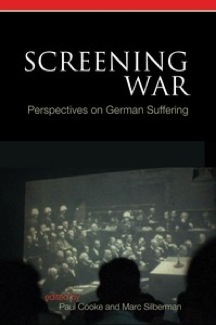 In one new publication, Screening War: Perspectives on German Suffering (Camden House), Paul Cooke, a professor of German cultural studies at the University of Leeds, and Marc Silberman, a professor of German at the University of Wisconsin, collect essays about the impact on German visual culture of German wartime suffering. That includes a spate of films dealing with German trauma and memory, they and their fellow authors note. But Cooke and Silberman also note that films addressing the sensitive issue have a long tradition in German cinema. They suggest that earlier films, and the way they compare with films of the last decade, illustrate evolving German attitudes towards Germany’s and Germans’ wartime trauma. [Read an interview with Marc Silberman]
In one new publication, Screening War: Perspectives on German Suffering (Camden House), Paul Cooke, a professor of German cultural studies at the University of Leeds, and Marc Silberman, a professor of German at the University of Wisconsin, collect essays about the impact on German visual culture of German wartime suffering. That includes a spate of films dealing with German trauma and memory, they and their fellow authors note. But Cooke and Silberman also note that films addressing the sensitive issue have a long tradition in German cinema. They suggest that earlier films, and the way they compare with films of the last decade, illustrate evolving German attitudes towards Germany’s and Germans’ wartime trauma. [Read an interview with Marc Silberman]
The book comes soon after a similar volume from Camden House, issued in 2009: Germans as Victims in the Literary Tradition of the Berlin Republic, edited by Stuart Taberner and Karina Berger. Essays in that collection addressed the increasing willingness of Germans to discuss events at the war’s end, and the persistent traumatization of Germans who were alive at that time.
The volume’s contributors noted a small boom in writing relating to such experiences, including W.G. Sebald’s On the Natural History of Destruction (Random House, 2003), which asked why so little German literature had considered such events as the Allied air attacks that had taken 600,000 German lives and left more than seven million Germans homeless.
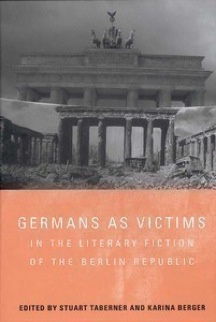 The expulsion of ethnic Germans from Eastern Europe was prominently considered in the volume – much-discussed, for example, was the Nobel laureate Günter Grass’s Crabwalk (Harcourt, 2003), a historical novel that explored, as a sort of emblem of retribution against Germans, the sinking by a Soviet submarine of a German refugee ship in January 1945.
The expulsion of ethnic Germans from Eastern Europe was prominently considered in the volume – much-discussed, for example, was the Nobel laureate Günter Grass’s Crabwalk (Harcourt, 2003), a historical novel that explored, as a sort of emblem of retribution against Germans, the sinking by a Soviet submarine of a German refugee ship in January 1945.
Contributors to both Camden House publications relate that the late 1940s and early 1950s saw an intense focus on the issue of German victimhood, but then guilt, shame, and blame took over, ushering in a long period when Germans were excoriated as perpetrators and maintained a silence that signaled that the anger was reaching its mark. Only from the mid-1990s did that focus shift again to allow that while millions of Germans certainly were Nazis or abetted the mass murderers – were indulgers in “everyday evil”– millions of Germans also were victims of both their wartime rulers’ savagery and the cold calculus of Allied retribution.
Filming in the Rubble of War
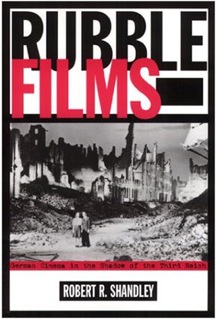 Among other publications on the subject has been Temple University Press’s 2001 release, Rubble Films: German Cinema in the Shadow of the Third Reich, by Robert R. Shandley. The book’s title referred to the Trümmerfilme – “rubble films” – made under Allied supervision after World War II among the rubble of bombed-out German cities, even as German women, the trümmerfrau, picked their way through the ruins to salvage whatever could serve in any way to shore up postwar life.
Among other publications on the subject has been Temple University Press’s 2001 release, Rubble Films: German Cinema in the Shadow of the Third Reich, by Robert R. Shandley. The book’s title referred to the Trümmerfilme – “rubble films” – made under Allied supervision after World War II among the rubble of bombed-out German cities, even as German women, the trümmerfrau, picked their way through the ruins to salvage whatever could serve in any way to shore up postwar life.
Shandley analyzed 17 films made between 1946 and 1949, some well known, some deservedly obscure but still useful indices of cultural conditions of the day. Among the detective tales, satires, and melodramas were popular features such as The Murderers Are Among Us (1946) and In Those Days (1947).
Shandley unearthed some strange titles, too, none more so than Long is the Road, a 1948 Yiddish/German production touting the benefits of migrating to Palestine and a satire of postwar life rendered as biblical allegory, The Apple is Off! (1948).
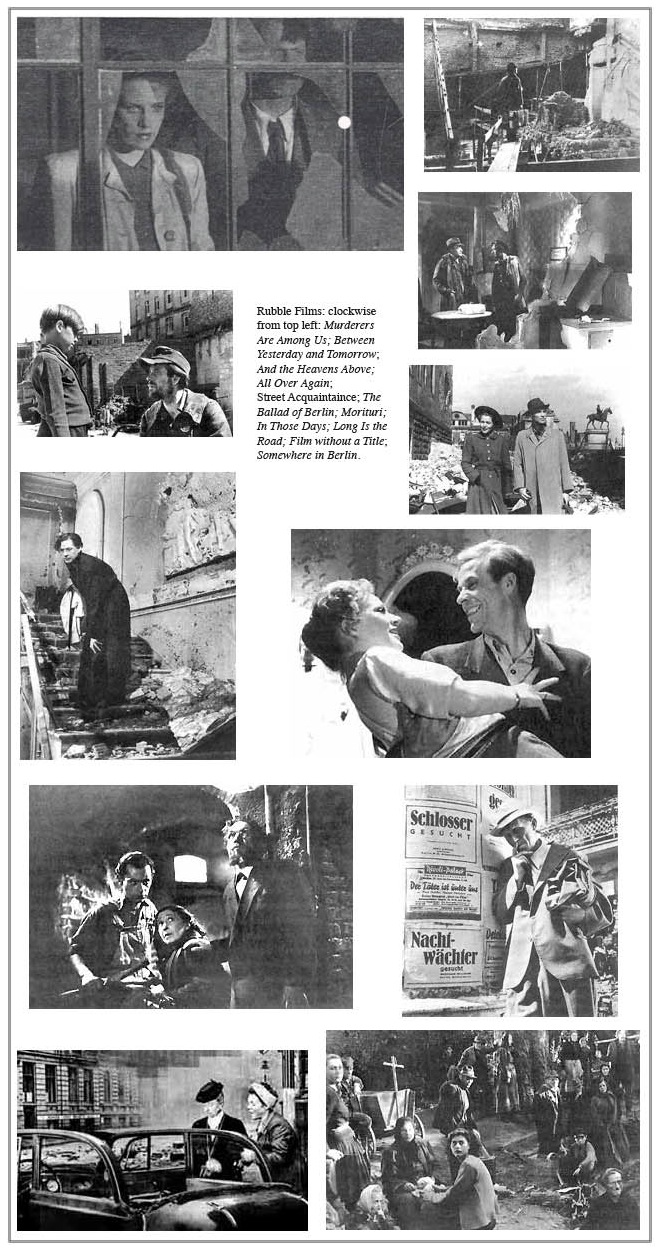
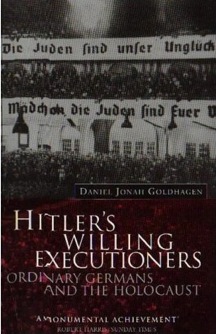 Shandley had earlier edited a volume of essays Unwilling Germans: The Goldhagen Debate (1998) that traced German resistance to Harvard historian Daniel Goldhagen’s 1996 indictment of German citizens in wartime, Hitler’s Willing Executioners: Ordinary Germans and the Holocaust. So he could not have been surprised to find that German filmmakers’ strong tendency after the war was to avoid Nazis war atrocities, and certainly to steer away from the kinds of films the Nazi war machine had earlier made in large numbers – many of those were light fare: musicals, comedies, and the like.
Shandley had earlier edited a volume of essays Unwilling Germans: The Goldhagen Debate (1998) that traced German resistance to Harvard historian Daniel Goldhagen’s 1996 indictment of German citizens in wartime, Hitler’s Willing Executioners: Ordinary Germans and the Holocaust. So he could not have been surprised to find that German filmmakers’ strong tendency after the war was to avoid Nazis war atrocities, and certainly to steer away from the kinds of films the Nazi war machine had earlier made in large numbers – many of those were light fare: musicals, comedies, and the like.
He also found that the rubble films tended to seek to assuage German guilt by conflating Third Reich crimes and German postwar suffering, as if the latter might excuse the former. The feint, he observed, seemed designed to help blameworthy Germans to persuade themselves that they had not been Hitler’s willing executioners, after all, but had instead undertaken an “inner emigration” – they had remained in Germany not as Nazis but as critical or hobbled observers of Nazi leaders.
Even more bracing, wrote Shandley, was the way many films portrayed Germans as needing to win back the trust of fellow Germans who shared their guilt, but never the trust of the victims of the Nazi regime. Shandley carefully observed not only what films of the period included, but what they did not.
Take the case Helmut Käutner’s first postwar film, In jenen Tagen (In Those Days, aka Seven Journeys) of 1947. Käutner was no hack – in fact, he was sufficiently admired in Germany for his long career that in 1980 he was honored with a postage stamp. In jenen Tagen purported to show a cross-section of German society, including a Jewish couple and a composer who had been labeled as subversive.
That has long brought the film positive notices. For example, earlier this year, 2010, when it was shown in a Käutner retrospective by the Harvard Film Archive and the Goethe Institut Boston, program notes praised Käutner: “During a time when most Germans wanted to forget the past, Käutner eschewed the controlled setting of the UFA [key German] studios and chose to film in the bombed out streets of Berlin, crafting a humanistic rendering of recent history.”
The notes also observed that Käutner had himself been a target of Nazi censors – they banned his directorial debut Kitty and the World Conference (1939) due to its “pro-English tendencies.” The notes continued: “Although active in the German film industry during the Third Reich, Käutner’s work was noted for its more humanistic depiction of daily life than his contemporaries. He rejected the UFA filmmaking establishment and produced thoughtful works which considered the struggles of the German people during a period of great turmoil.”
But Shandley is less sanguine. Käutner’s film, he observes, “tells seven stories of innocent Germans, while neglecting to portray the culpability of others.” In that respect, it had many kin, during the postwar years, Shandley says: “Most of the films treat the question of guilt as just one problem among many in the postwar period.” Self-absolution could be cinematically persuasive even if historically suspect: “The black market is represented as being as distressing as, or even worse than, the presence of war criminals. The German refugees from Silesia and the former German soldiers returning from war often occupy the same symbolic position as the survivors of the death camps.”
“The rubble films’ treatment of the past is far from morally satisfying to today’s viewers,” he concluded with considerable understatement. Films like Harald Braun’s 1947 Zwischen Geseern und Morgen (Between Yesterday and Tomorrow), Peter Pewas’s 1948 Straßenbekanntschaft (Street Acquaintance), and R.A. Stemmle’s 1948 Berliner Ballade (The Ballad of Berlin), he wrote, “only rarely confront the institutions, traditions, and assumptions that led to the catastrophe that was postwar Europe. At best, they mention them; at worst, they lie about them.”
Thus, he wrote, “these films can be seen as training films for the attitude of dismissal regarding the Holocaust that has often prevailed in public discourse in Germany in the ensuing fifty years.”
Framing Suffering
Shandley identifies one telling factor in the slant of films of the period: that they were generally made by directors who had been favored by, and often employed by, the Nazi regime of the years only just past. He writes: “Just as the agitators who founded the ‘New German Cinema’ in the 1960s charged, there was no discernable difference between the personnel of the [film] industry during and after the war.” For example, Wolfgang Liebeneiner, artistic director of the leading film company of the Nazi era, after the war continued on as a film director.
 Just out (November 2010) is another new book, Berlin at War, by Roger Moorhouse (Basic Books); the subtitle of the British edition is Life and Death in Hitler’s Capital, 1939-45. It marshals an array of primary sources to detail many aspects of life in the German capital – rationing, air-raid defenses, propaganda, surveillance, the presence of many slave laborers –Czech, Dutch, French, Polish, Ukrainian… – which must surely have alerted even the most self-absolving Nazi sympathizers that something terrible was afoot.
Just out (November 2010) is another new book, Berlin at War, by Roger Moorhouse (Basic Books); the subtitle of the British edition is Life and Death in Hitler’s Capital, 1939-45. It marshals an array of primary sources to detail many aspects of life in the German capital – rationing, air-raid defenses, propaganda, surveillance, the presence of many slave laborers –Czech, Dutch, French, Polish, Ukrainian… – which must surely have alerted even the most self-absolving Nazi sympathizers that something terrible was afoot.
Reconsideration of German suffering has been growing during the last decade. Julia M. Klein, an American literary critic, wrote in a 2003 essay, “Germans as Victims of World War II,” that “even as Berlin remakes itself into a 21st-century showplace of skyscrapers and museums, and Dresden painstakingly recreates its Baroque heart brick by brick, the issue of German victimization has exploded more forcefully into popular consciousness.”
 She cites a number of books that demonstrate renewed willingness to consider how much the war and its aftermath cost Germans. Anthony Beevor’s The Fall of Berlin 1945 (Viking Press, 2002, later translated into German), described the Red Army’s vengeful brutality as it invaded Germany. In Der Brand: Deutschland im Bombenkrieg 1940-45 (Propyläen Verlag, 2002; published in English translation by Columbia University Press in 2006 as The Fire), the Holocaust scholar Jörg Friedrich described painstakingly the Allies’ destruction of city after city in Germany with 80 million incendiary bombs. (Controversially, he distorted some details of German and Allied wartime bombings, and used Holocaust terminology to describe Allied actions – for example, he appropriated the word “crematoria,” that had been used to refer to the ovens of Auschwitz, to describe incinerated Dresden air-raid shelters.)
She cites a number of books that demonstrate renewed willingness to consider how much the war and its aftermath cost Germans. Anthony Beevor’s The Fall of Berlin 1945 (Viking Press, 2002, later translated into German), described the Red Army’s vengeful brutality as it invaded Germany. In Der Brand: Deutschland im Bombenkrieg 1940-45 (Propyläen Verlag, 2002; published in English translation by Columbia University Press in 2006 as The Fire), the Holocaust scholar Jörg Friedrich described painstakingly the Allies’ destruction of city after city in Germany with 80 million incendiary bombs. (Controversially, he distorted some details of German and Allied wartime bombings, and used Holocaust terminology to describe Allied actions – for example, he appropriated the word “crematoria,” that had been used to refer to the ovens of Auschwitz, to describe incinerated Dresden air-raid shelters.)
 Klein also discussed a “long tradition” of Germans “seeing themselves, both with justification and without, as victims of the Versailles Treaty, hyperinflation and unemployment, the Nazis, Allied air attacks, the brutal Russian advance, and even de-Nazification efforts.” In that connection, she cited Shattered Past: Reconstructing German Histories (Princeton University Press, 2003), in which historians Konrad H. Jarausch, of the University of North Carolina at Chapel Hill, and Michael Geyer, of the University of Chicago, considered the “selective perception” that allowed older Germans, in particular, to overlook their own participation in World War II’s mass killing, genocide, and slave labor but to indulge instead a ” victimization perspective” in their recollections of the war and the chaos at its conclusion.
Klein also discussed a “long tradition” of Germans “seeing themselves, both with justification and without, as victims of the Versailles Treaty, hyperinflation and unemployment, the Nazis, Allied air attacks, the brutal Russian advance, and even de-Nazification efforts.” In that connection, she cited Shattered Past: Reconstructing German Histories (Princeton University Press, 2003), in which historians Konrad H. Jarausch, of the University of North Carolina at Chapel Hill, and Michael Geyer, of the University of Chicago, considered the “selective perception” that allowed older Germans, in particular, to overlook their own participation in World War II’s mass killing, genocide, and slave labor but to indulge instead a ” victimization perspective” in their recollections of the war and the chaos at its conclusion.
Suffering on Film
How does all this look, then, from the perspective of film? In Screening War, Cooke, Silberman, and their fellow essayists trace the ways German film depictions of German wartime and postwar suffering have evolved. The writers consider many films of the 1950s, most of which would be forgettable if not for the light they throw on subjects such as Cooke and Silberman’s. The two editors also consider more recent works, such as Margarethe von Trotta’s Rosenstrasse (2003), Oliver Hirschbiegel’s Oscar-nominated Downfall (2004), and the two-part television mini-series Dresden (2006).
The essays address frankly a topic that had been taboo for German filmmakers once the handwringing of the 1950s was discredited. The book results from a three-year collaboration funded by the British Arts and Humanities Research Council, “From Perpetrators to Victims? Discourses of German Wartime Suffering from 1945 to the Present.” Cooke and Silberman invited scholars from both sides of the Atlantic to a June 2007 meeting at the University of Leeds to shape the project. Then, in November 2008, the collaborators presented papers at the 41st Wisconsin Workshop in Madison. Finally, the papers were improved for inclusion in the volume of essays, which Cooke and Silberman characterize as a contribution to postwar “memory work” in Germany.
They say in their introduction that their and their fellow essayists’ interest was to take another look at thematic choices and aesthetic strategies of German filmmakers’ from the 1950s to the present, to see what they revealed about claims about, and attitudes towards, German suffering.
They wished to reconsider, then, familiar features and genres, and to draw attention to new or overlooked material: How were films framed? What did films’ structures hide? To what extent did the films present or perhaps subtly reflect social trauma? What could all that reveal about the changing status of German victimhood in cultural and political discourse?
In one of their findings, they echo Shandley’s understanding of the “rubble films,” a rather appalling one: In the years immediately after the war, a discourse of German suffering – even of a sort of historic German victimhood – took hold and became a commonplace of German cultural expression. In West Germany, the authors found, official gestures of Vergangenheitshewältigung (coming to terms with the past) emphasized atonement and reconciliation, but popular sentiment more often indulged notions of German victimization, first by Nazis, then by Communists after the war.
Thus it was after the first Nuremberg trials of November 1945 to October 1946. A sort of “triage of perpetrators and victims” arose, note Cooke and Silberman. In his 1945-46 lectures, The Question of Guilt, the philosopher Karl Jaspers responded to Germans’ desperation to repulse accusations of collective guilt for Nazi crimes by differentiating between individual guilt and collective political responsibility. His, say Cooke and Silberman, was an “early and remarkable attempt to navigate the shame and disorientation that came to mark the postwar years.”
Silence was the dominant stance towards guilt, even though various events cause guilt, itself, to flare. One was the 1961 trill of SS officer Adolf Eichmann in Jerusalem. At the time, Hannah Arendt’s commentaries on the “banality of evil” detailed Nazi machinery and “revealed the empty excuses of the Schreibtischtäter,” the “desktop perpetrators” with spurious excuses for themselves, write Cooke and Silberman.
They note that 1963-65 Auschwitz trials rekindled such questions of guilt because they “brought the victims of the ‘banality of evil’ right into Germany’s evening news and living rooms.”
The nadir for German denial came in the 1960s when children born during or after the war demanded explanations from people of their parents’ generation. And yet, write Cooke and Silberman, “for all their media treatments of the war and its consequences, the postwar generation failed to bring about in the general population the desired mindset,”
That is no surprise, given the kinds of cinema and television films that emerged from that period of questioning. Many valorized the concept of the family with “melancholic tales of orphans, broken families, and neglected children seeking escape or revenge,” they write.
Just as telling was German reception of films and television programming that might have produced a new awareness, but instead seemed to encourage further entrenchment, they add. For example, in 1979, West German television broadcast the American TV series Holocaust (1978), by Marvin J. Chomsky and Gerald Green. It portrayed the opposing fates of two families in Berlin, one Nazi and one Jewish, but the response, they write, “confirmed on the one hand the continuing widespread amnesia about the Nazi past and on the other the willingness on the part of the popular audience to acknowledge at last a measure of complicity for past crimes.”
Citing the books by Sebald, Grass, Friedrich, and others that featured in the earlier Camden House book, Germans as Victims in the Literary Tradition of the Berlin Republic, Silberman and Cooke note that from the late 1990s, German “suffering” and victimhood during and after the war again became a prominent cultural theme. Other manifestations include a four-part series on “Germans as Victims” in the leading periodical, Der Spiegel; TV historian Guido Knopp’s popular television documentaries on the subject; and many feature films and television miniseries.
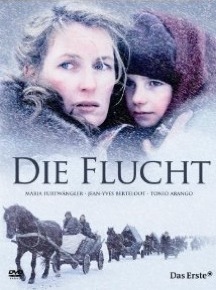
 Just as Robert Shandley questioned how much Helmut Käutner’s In jenen Tagen (In Those Days, aka Seven Journeys, 1947) really did call into question German presumptions about their own suffering, several of the essayists in Silberman and Cooke’s book look skeptically at the motivations, conscious or not, of films of the last decade, including what they call “a wave of miniseries, commissioned by German public-television broadcasters. Those include Die Flucht (March of Millions, ZDF, 2004), Dresden (ZDF, 2006), and Die Gustloff (Ship of No Return, ZDF, 2008).
Just as Robert Shandley questioned how much Helmut Käutner’s In jenen Tagen (In Those Days, aka Seven Journeys, 1947) really did call into question German presumptions about their own suffering, several of the essayists in Silberman and Cooke’s book look skeptically at the motivations, conscious or not, of films of the last decade, including what they call “a wave of miniseries, commissioned by German public-television broadcasters. Those include Die Flucht (March of Millions, ZDF, 2004), Dresden (ZDF, 2006), and Die Gustloff (Ship of No Return, ZDF, 2008).
Among recent films are:
NaPolA (Before the Fall, 2004), directed by Dennis Gansel: Nazis recruit an aspiring boxer to train at their barracks; he accepts, over the objection of his father who detests Hitler; the young boxer encounters an ethical crisis when he finds he is being trained not to box, but to kill.
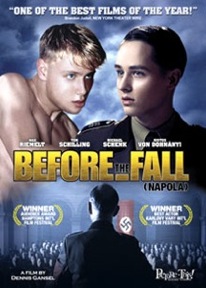
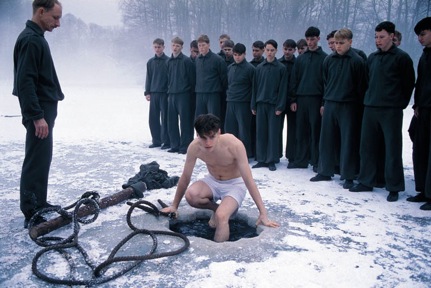
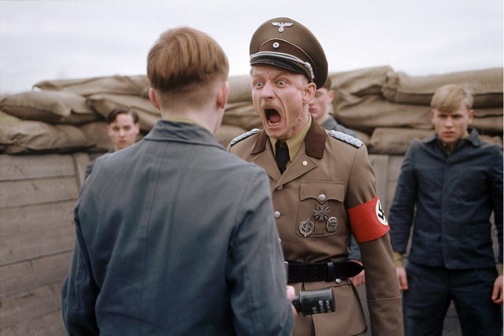
Rosenstrasse (The Women of Rosenstrasse, 2003), by Margarethe von Trotta: A German-American woman travels to Berlin to try to find out how she was saved from the Nazis, and why her mother will not reveal the full story behind that event.
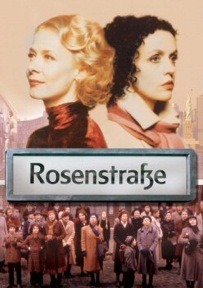
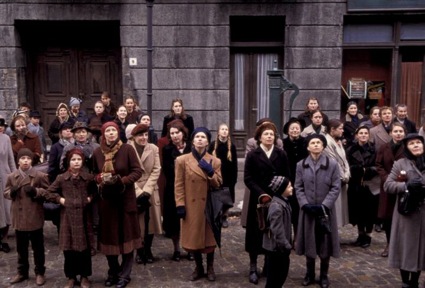 Anonyma – Eine Frau in Berlin (A Woman in Berlin, 2008), by Max Farberbock: In 1945, during the Red Army invasion of Berlin, a woman journalist seeks protection from wholesale rapes of German women; she finds a Russian officer whom she hopes will save her, but her accommodation turns to affection.
Anonyma – Eine Frau in Berlin (A Woman in Berlin, 2008), by Max Farberbock: In 1945, during the Red Army invasion of Berlin, a woman journalist seeks protection from wholesale rapes of German women; she finds a Russian officer whom she hopes will save her, but her accommodation turns to affection.
Taboo or No Taboo, in West and East Germany
While marketing and media reception of such film and television series harp on about how they mark a break with a decades-long taboo on addressing wartime guilt and experience, in fact that “has never been ‘taboo’,” the editors contend. That was even true, although in a different way, of films made in East Germany, they note.
In East Germany, official rhetoric with regard to West Germany was that it protected war criminals, regardless of such gestures of acceptance of guilt by West German leaders as making reparations and restitution to Jewish survivors. Party officials trumpeted the claim that wartime suffering had forged solidarity and integration, and that provided “effective strategies of self-explanation and self-exculpation.” Still, write Silberman and Cooke, “institutions and families wrapped the lived trauma and felt shame of the past in silence.”
The result, they write, was that “those who were willing to identify with the suffering of the antifascist resistance and with the Soviet losses in the war could reinvent themselves as victims of fascism, understood to be an extreme form of capitalist exploitation.”
Some cultural figures contested this way of construing the East’s wartime legacy. In 1965, for example, Heiner Müller, in his revision of Sophocles Philoctetes, probed generational guilt and political lying that was designed to gloss over it. Novelists Christa Wolf and Hermann Kant also explored that phenomenon. For Silberman and Cooke, Frank Beyer’s Oscar-nominated film, Jakob der Lügner (Jakob the Liar), 1975, an adaptation of Jurek Becker’s play, marked a high point in East German cinema by directly confronting German criminality during the Holocaust.
But Cooke and Silberman argue that however differently West and East processed wartime guilt, it remained a troubling force in both Germanys, and then in the reunified one, post-1989. Before the wall fell, the waters were roiled by such figures as US president Ronald Reagan (the conciliatory and highly contentious visit to Bitburg military cemetery) and German chancellor Helmut Kohl (his plan for a historical museum in Bonn that would demonstrate how much Germany had changed, spiritually and morally).
The editors suggest that the fall of the wall in 1989 and the revelations of the obvious that it permitted – the criminalism of Communist leaders – ushered in a new phase where victimhood became a more acceptable presumption in all of now-reunified Germany.
This troubled intellectuals like Jürgen Habermas, who proposed that the identity of reunified Germany should not be nationalist, but rather based on consciousness of Auschwitz – “the open wound that keeps alive both the memory of the Holocaust’s victims and the need for a transformative culture of atonement,” as the editors write.
Debates over such issues, note Cooke and Silberman, have continued to be the backdrop for a new spate of films that emerged along with a wealth of films on DVD and Internet archives that capture and dispense data but do not necessarily decrease the tendency to choose evasively what to remember.
Read an interview with Marc Silberman.
An excerpt from Paul Cooke and Marc Silberman’s introduction to Screening War: Perspectives on German Suffering
The general consensus that the German past will never be adequately “bewältigt” [dealt with] because of the extreme nature of its historical and moral guilt does not contradict the fact that postwar Germany’s own discourse on Vergangenheitsbewältigung [coming to terms with the past] has in some ways become the model for efforts of international institutions to think about guilt in the context of tribunals and truth commissions. Memory is inevitably constructed from a contemporary perspective, and the struggle of the “right” way to remember is one that shapes both cultural discourses and political legitimacy. In recent times, the flood of media and mediated images of the past has triggered a mini-boom in critical memory studies and generated new strategies of remembering as well as insistent questions about who is remembering what. The inflation of oral histories and “private” memories enriches the archive with a proliferation of different stories, but the swelling archive also challenges the epistemological privilege of professional historiography and its preference for coherent, linear explanations. The shifting definition of victims and victimization belies the established discourse of contrition, while at the same time various groups vie for recognition of their victim status. Clearly, mnemonic practices are ideological activities of individuals and groups who engage in the production of meaning. These practices are themselves historical in nature, subject to counternarratives, realignments in social and political relations, and modifications in dominant discourses. Screening War focuses on phases, generations, continuities, and ruptures within the field of memory construction on film. The power of past events, persons, images, and narratives to generate new stories and reflections on the present marks the proverbial persistence of memory, and the essays [in Screening War] show how this kind of memory is put to public use onscreen and offscreen in the continuing process of shaping and forgetting the past.” Dresden, bombed; Deutsche Fotothek
Dresden, bombed; Deutsche Fotothek
Printed from Moving Image Archive News: http://www.movingimagearchivenews.org
URL to article: http://www.movingimagearchivenews.org/framing-german-wartime-suffering/
Click here to print
